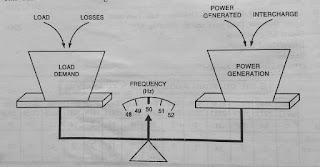Balancing And Frequency Control
Frequency is maintained in an interconnection as long there is a balance between power generation and load demand (plus losses).
 |
| Balancing and Frequency Control |
If a municipality operates its own water system, it would need sufficient pumps (generation) to maintain water level in a storage tank (frequency) to serve its customers.
The frequency regulation/control may be manual or automatic, but in a large interconnected power system, manual regulation is not feasible.
The important control loops in interconnected power system are:
- Load Frequency control
- Automatic Voltage control
 |
| schematic diagram of load frequency and excitation voltage regulators |
Fig. gives the schematic diagram of load frequency and excitation voltage regulators of a turbo generator.
The controller are set for a particular operating condition and they take care of small changes in load demand without frequency and voltage exceeding the prescribe limit.
If the change in load demand becomes large, the controller must be reset either manually or automatically.
Necessity Of Maintaining Frequency Constant :
1.All the AC motors require constant frequency as to maintain constant speed.
2.In continuous process industry, it affects the operation of the process itself.
3.For the synchronous operation of various units in the power system network, it is necessary to maintain frequency constant. If the normal frequency is 50 Hz and the system frequency falls below 47.5 Hz or goes up above 52.5 Hz then the blades of the turbine are likely to get damaged so as to prevent the stalling of the generator.
4.Frequency affects the amount of power transmitted through interconnected lines.























0 Comments